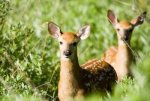"Spotting" North American
Whitetail Fawns
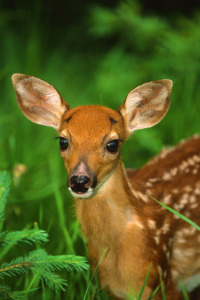
Whitetail Fawn in the
Summer
North American Whitetail Fawns are truly beautiful creatures, from the time that they are born they are working to survive and learning new skills. If you look closer at whitetail deer facts, you'll find that the summer time is one of the most interesting times for fawns.
Although usually
summer is a time when bucks and does are a bit more lazy than usual,
the summer time is all about learning new things for whitetail deer fawns. There is
much to be learned before the fall and winter, and they spend the
summer frolicking and learning more about life as a whitetail deer.
During the summer the fawns are starting to grow and now they can actually recognize their own mother by her scent. They are learning more about the world from the mother North American Whitetail doe, and spend a lot of time observing the other deer in their deer habitat.
Often during the late summer you'll actually begin to see whitetails begin to herd up, with bucks, doe, and fawns all running together in the same group for awhile.
This is a
prime time for whitetail deer fawns to learn more about how they are
supposed to be, with young male fawns watching and learning from the
bucks.
You'll find that the whitetail deer fawns also begin to really build up during the summer. They begin to learn how they can graze in the deer habitat by imitating the does, so then they don't have to rely so much on their mother's milk.
This will help the fawns to build up fat reserves for the winter that will be along in a few months.
Fawns also begin to molt in the late summer as well, just as their mothers often do. Instead of keeping their reddish summer coat that has white spots on it, they will then start getting a coat that is grayish brown, which helps to make them blend in better as the trees begin to lose their leaves.
Often during the summer months, you'll see the buck fawns
get small lumps on their head where they will develop antlers when they
are a bit older.
In some cases some of the doe fawns may end up being bred their first fall, so their body is often preparing itself for the breeding season. About 60% of American Whitetail doe fawns will breed when they are only about 6 months old, although they usually will only have one fawn their first year.
Also, you'll find the North American Whitetail fawns all eat a lot during the summer, since they have to build up as much as possible for the coming winter months.
The summer is definitely a period of growth and
learning for the whitetail deer fawn, and much of what they learn now
will determine whether or not they will be able to survive into
adulthood.
Natural Protection
The fawn is also weaned by the time it loses its spots. By November the average whitetail male fawn will weigh close to 80 to 85 pounds, and the female fawn will weigh 75 to 80 pounds.
As the spots disappear, the fawn's coat also changes from its reddish color to a grayish winter coat. The buck fawn's face grows a bit darker in color but the belly remains white.
When a fawn is born it is odorless so that predators are not attracted to its location. In fact the mother doe will stay away from the fawn for a few days so that her scent does not rub off on the fawn or attract predators to the area where the fawn is hiding while gaining strength.
When a fawn
detects danger it will remain perfectly still. Fawns that live past the
first week have a good chance of surviving to adulthood.
Mom to the Rescue
Fawns normally don't make any noises except for occasional bleating when in distress. When the fawn bleats and the doe is unable to see the fawn, she will come running to the fawn's rescue. A doe and her fawns live as a family group until the fawns are weaned.
Sometimes multiple does and whitetail deer fawns will group together. Interestingly, the deer habitat where the fawn is born normally becomes its adult habitat.
Whitetail Deer Fawn
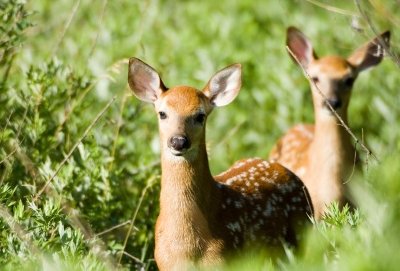
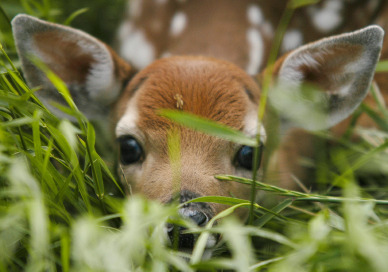 The buck fawn above is only a few days old. You can see the two round spots on his head between his ears and eyes that gives this information.
The buck fawn above is only a few days old. You can see the two round spots on his head between his ears and eyes that gives this information.
The two below are a few months old and getting a lot wiser to the ways of the Whitetail Deer World. The one facing the camera is a buck because you can see the nubs on his head sticking up about an inch in the same spot as the picture above.
Now one always hopes this guy will be a record whitetail deer.
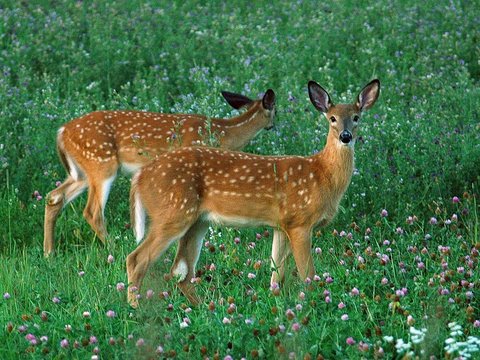
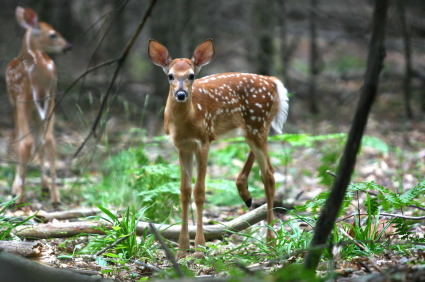
Thank you for stopping by and please feel free to contact us to let us know what your think about our site. Give us your suggestions for changes and we will do our best to make those changes.
Whitetail Resources
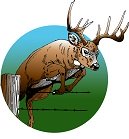
Field Dressing a Deer Instructional Ebook
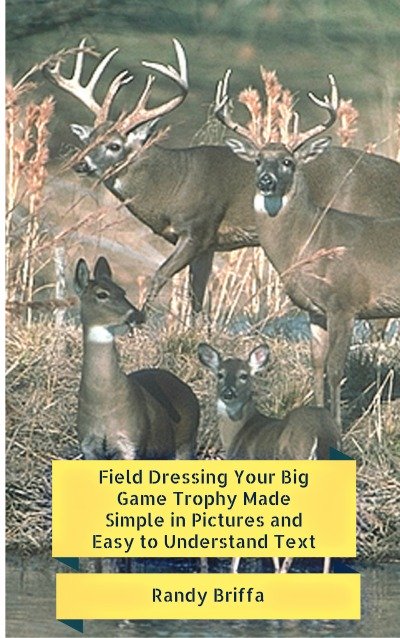
Price: $9.95

My New Site Dedicated To Deer Hunting
Recent Articles
-
Biggest Whitetail Deer
Aug 31, 24 09:18 PM
Fall is the time for the Biggest Whitetail Deer to assert their dominance during the rut. -
Whitetail Deer Fawn Fall
Aug 31, 24 09:17 PM
Whitetail deer fawns are born in late spring with spots. By winter they have lost their spots and their coats have changed color. -
North American Whitetail Fawns
Aug 31, 24 09:17 PM
North American Whitetail deer fawns are born in late spring with spots. By winter they have lost their spots and their coats have changed color.
My New Site Dedicated To Deer Hunting

Questions and Comments
Please use the contact us page for any questions or comments you may have. We may post them on our site with a reply. You will also receive a personal reply from us. We want to make this site as relevant to your needs as we can. Just let us know how we can help you.
And thanks for stopping by. Have a great day.
Randy


